Telescopes
Bayfordbury Observatory's facilities include seven permanently-mounted optical telescopes, four radio telescopes, a solar telescope array, and various other small astronomical instruments.
The optical telescopes and solar array are housed inside eight high-quality motorised Ash domes.
The six newest optical telescopes use a range of CMOS and CCD cameras with specialist filters to take detailed images of objects in space, from the nearby moon and planets to nebulae and distance galaxies.
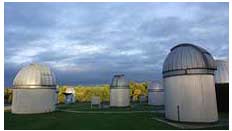 Three of these telescopes are fully robotic, meaning that they can run autonomously throughout the night without human intervention. This allows students and staff to get the very most out of the available hours of clear sky.
Three of these telescopes are fully robotic, meaning that they can run autonomously throughout the night without human intervention. This allows students and staff to get the very most out of the available hours of clear sky.
The older permanently-mounted optical telescope is a simpler platform for students to be introduced to astronomy, where they can move the telescope themselves and get a chance to look through the eyepiece.
Our radio telescopes allow detailed observations to be made of the hidden hydrogen that makes up our own galaxy, as well as high-energy radio sources inside and outside our galaxy. An advantage of radio telescopes is that they can be used in both the day and night, and during cloudy weather.
| Name | Type | Detector | Filters |
|---|---|---|---|
| 24" Telescope | 61cm Planewave CDK24 | ZWO ASI6200MM Pro | BVR (Johnson), H-alpha, S-II, O-II |
| J.C.D. Marsh Telescope | 50cm f/13 Cassegrain | Eyepiece | - |
| R. Priddey Telescope | 41cm Meade LX200-ACF | ZWO ASI6200MM Pro | BVRI (Johnson) |
| J. Hough Telescope | 41cm Meade LX200-ACF | ZWO ASI6200MM Pro | BVRI (Johnson), H-alpha, S-II, O-II |
| C.R. Kitchin Telescope | 41cm Meade LX200GPS | ZWO ASI6200MM Pro | BVR (Johnson), H-alpha |
| I.K.M. Nicolson Telescope | 41cm Meade LX200 | Moravian Instruments G4-9000 | |
| Video Telescope | 36cm Meade LX200R | Lumenera SKYnyx 2-1 | Red, Green, Blue, IR, UV |
| Vince Telescope | 17cm f/13.5 refractor | Eyepiece | - |
| Solar telescope array | 4x 70-102mm refractors | 4x ZWO ASI178MM | 2x H-alpha, Ca-k, Continuum |
| R.W. Forrest Telescope | 4.5m parabolic radio dish | 21cm/continuum | - |
| Radio Interferometer | 3x 3m parabolic radio dishes | 21cm/continuum | - |
24" Telescope
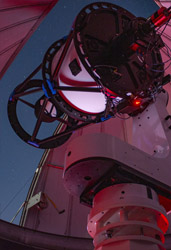 A Planewave CDK24 with a 24-inch (61cm) diameter mirror.
A Planewave CDK24 with a 24-inch (61cm) diameter mirror.- The Planewave L-600 direct-drive mount is capable of high speed slews with extremely accurate pointing and tracking.
- The ZWO ASI6200MM Pro 61 megapixel back-illuminated CMOS allows for very low levels of noise, high quantum efficiency, fast readout time and video capability.
- Installed in September 2021, it is both the newest and largest telescope at the Observatory.
J.C.D. Marsh telescope
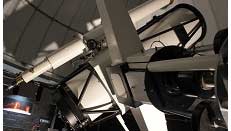 A 20-inch f/13 Cassegrain on a substantial English Cross-Axis mount.
A 20-inch f/13 Cassegrain on a substantial English Cross-Axis mount.- The first telescope to be installed at Bayfordbury, in 1970. It was later named after Lou Marsh, the first director of the Observatory.
- Originally built as a 16-inch (41cm) Cassegrain/Newtonian by Astronomical Equipment of Luton, and later modified by them in the mid-1980s to take the larger 20-inch (50cm) mirror.
- During the 1999 observatory renovation, a new dome was installed. The original dome was donated to Breckland Astronomical Society as part of the Great Ellingham Observatory.
Robert Priddey Telescope (RPT)
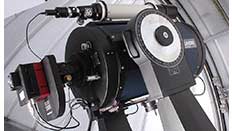 Installed in 2013, the RPT is a 16-inch Meade LX200-ACF that replaced an old manual Celestron C-14 from the late 1970s.
Installed in 2013, the RPT is a 16-inch Meade LX200-ACF that replaced an old manual Celestron C-14 from the late 1970s.- It is nominally equipped with an Moravian Instruments G4-9000 full frame camera, but is occasionally fitted with other instruments for student research projects.
James Hough Telescope (JHT)
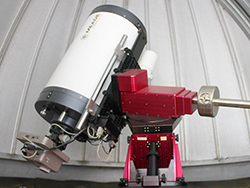 A 16-inch Meade LX200-ACF first installed in 2008, replacing the Henry Brinton Telescope.
A 16-inch Meade LX200-ACF first installed in 2008, replacing the Henry Brinton Telescope.- In 2013 it was moved onto a new robotic Paramount ME mount.
- It is equipped with a ZWO ASI6200MM Pro CMOS camera with an 8-position filter wheel.
Chris Kitchin Telescope (CKT)
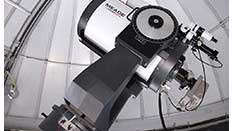 In 2005 a new 16-inch Meade LX200GPS was purchased for the Observatory by the East of England Science Learning Centre, and was installed in the dome formerly housing the Vince Telescope.
In 2005 a new 16-inch Meade LX200GPS was purchased for the Observatory by the East of England Science Learning Centre, and was installed in the dome formerly housing the Vince Telescope.- During late 2011 work was started on the CKT to convert it to robotic operation, and it became the first of up to 5 telescopes able to make automated observations of the night sky without anyone needing to be present.
- It is equipped with an ZWO ASI6200MM Pro camera with a 5-position filter wheel, holding BVR photometric and H-alpha filters.
Solar telescopes
Four telescopes on a single mount to image the Sun using different filters.
- A wide-field camera with occulting disk views near-sun atmospheric effects (haloes/sun dogs).
- Three 70mm telescopes view the entire sun with Hydrogen, Calcium and Continuum filters.
- A larger 102mm telescope views higher resolution details.
R.W. Forrest Radio Telescope
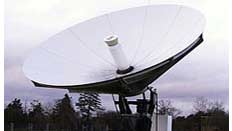 The Forrest Radio Telescope is a 4.5m, parabolic dish with a state-of-the-art 21cm (1.4GHz) Hydrogen line receiver.
The Forrest Radio Telescope is a 4.5m, parabolic dish with a state-of-the-art 21cm (1.4GHz) Hydrogen line receiver.- The receiver allows spectrum or continuum readings to be made.
- The telescope was built during the 1999 renovation to replace an older concrete radio dish.
- Mounted on a custom 'Alt-Az' mount which is controlled from the Patrick Moore Building.
Radio interferometer
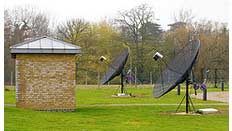 In December 2011 construction began on a 3-dish radio interferometer.
In December 2011 construction began on a 3-dish radio interferometer.- The dishes are 3m in diameter and have a maximum baseline of 115m.
- Receivers and a new positioning system for the dishes are currently being set up.
- It is believed to be the only radio interferometer in the UK that is used for teaching, and is one of only a very small number of teaching interferometers worldwide.
Video Telescope
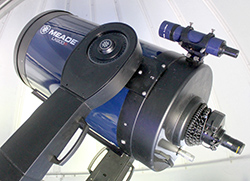 The Video Telescope is a 14-inch Meade LX200R installed in 2007.
The Video Telescope is a 14-inch Meade LX200R installed in 2007.- It specialises in fast frame rate, high resolution video imaging of solar system objects: the Sun, Moon and planets.
- It has 7 filters to allow observations to be made from the near-infrared (great for Mars) through red, green and blue to ultraviolet (for viewing cloud bands on Venus).
Iain Nicolson Telescope (INT)
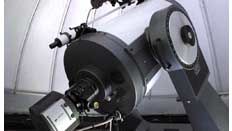 In 1999 a telescope identical to the DAT was installed and later named after astronomy lecturer Dr Iain Nicolson.
In 1999 a telescope identical to the DAT was installed and later named after astronomy lecturer Dr Iain Nicolson.- Piggy-backed on top is a 102mm apochromatic refractor with a Moravian G4-9000 CCD for widefield imaging of larger targets.
Vince telescope
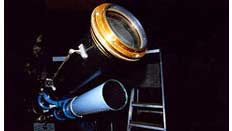 A 6.5-inch f/13.5 achromatic refracting telescope commissioned in 1934 by Albert Vince.
A 6.5-inch f/13.5 achromatic refracting telescope commissioned in 1934 by Albert Vince.- It uses a lens from an earlier telescope produced by the famous German opticians, Merz, in 1860, and is mounted in a brass cell manufactured by Hans Gordon of Berlin in around 1900.
- The son of the original owner had loaned the instrument to the Chelmsford Astronomical Society in the late 1970s and while there was extensively restored by the chairman, Mr Weston.
- The society later disbanded and the telescope sat in a garage for some time until it was donated to the observatory at Bayfordbury in 1988.
- During the 1999 renovation a dedicated 4m dome was built to house the telescope on its original half-ton mount, but in 2005 the newer Chris Kitchin Telescope was installed in this dome and the Vince telescope mounted on the 20-inch Marsh Telescope where it is today.
- The original mount was relocated to Ireland in 2011 to hold a Wray 6-inch f/15 refractor dating from the 1890s.
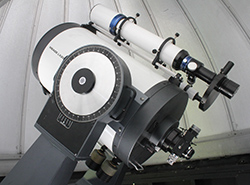 In 1995 the Observatory installed its first 'go-to' telescope - a 16-inch Meade LX200 EMC that could automatically find thousands of objects in the night sky using a computerised handset, one of the first of its kind in the country.
In 1995 the Observatory installed its first 'go-to' telescope - a 16-inch Meade LX200 EMC that could automatically find thousands of objects in the night sky using a computerised handset, one of the first of its kind in the country.- The telescope was decomissioned in 2021 to make way for the new 24" telescope. It is currently in storage until it can be repurposed or moved to a new home.
Historical Telescopes
Several telescopes have been retired from the Observatory, to make way for newer and more capable equipment. Some of these telescopes have been repurposed within the university, while others were donated to schools, colleges and amateur astronomical societies. Some of these telescopes have played notable roles in the history of the Observatory.
David Axon Telescope
Henry Brinton Telescope
- A 317mm Newtonian reflector built by George Calver in 1889.
- It was donated to the Hatfield Polytechnic Observatory in 1975 by Henry Brinton, at the suggestion of Patrick Moore.
- In 2008 it was passed on to Slindon College in Arundel.
